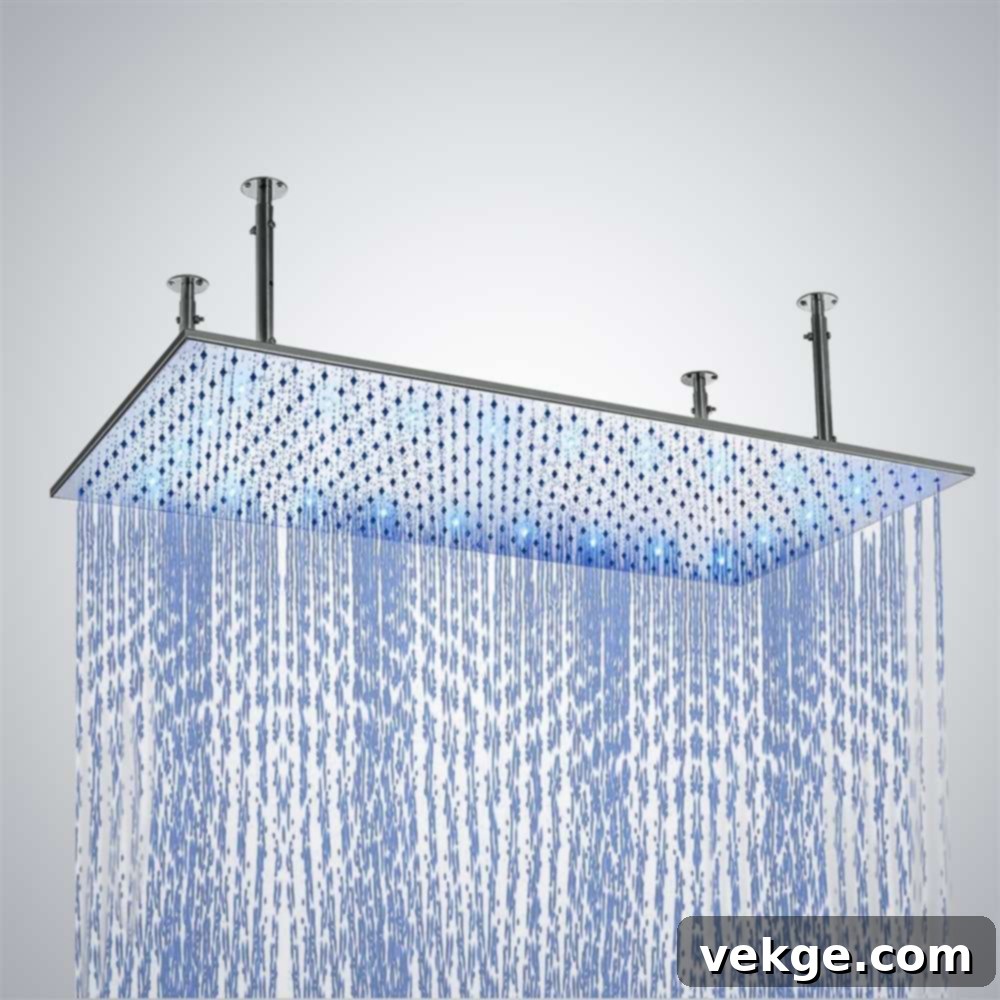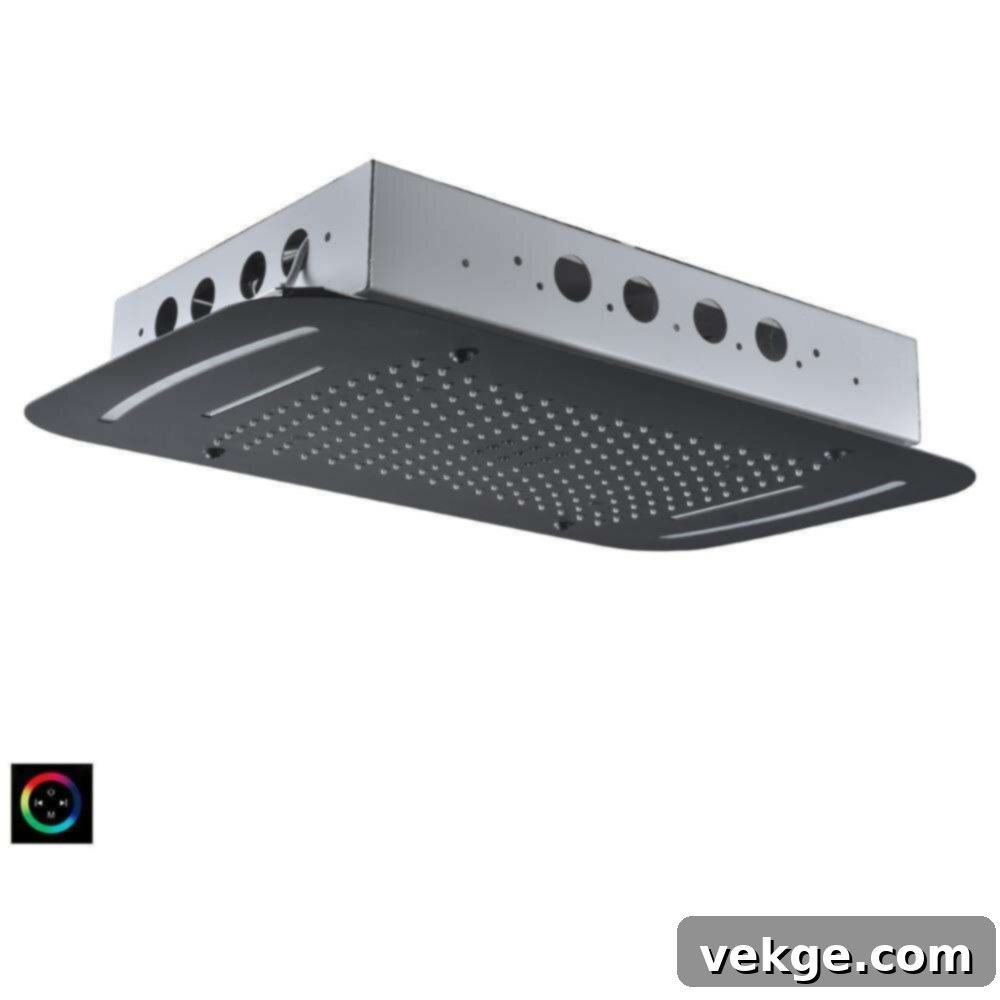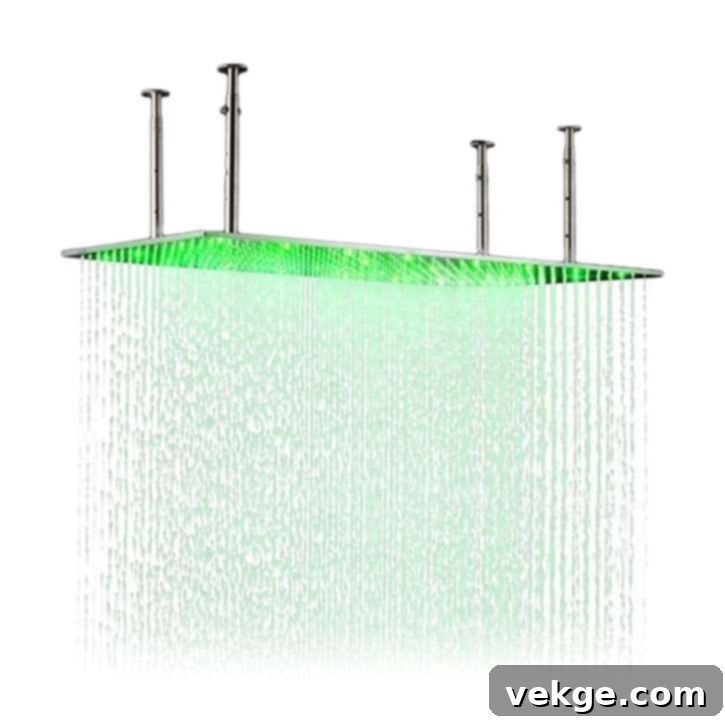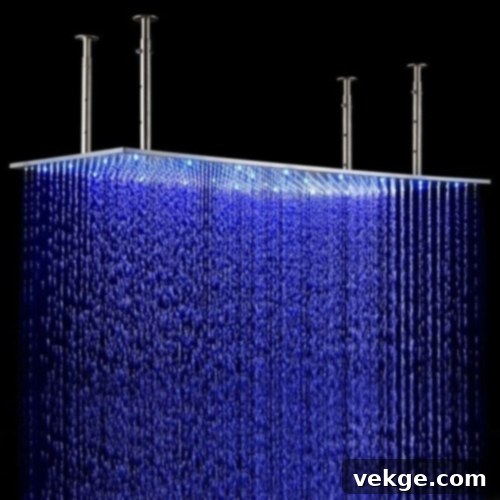Troubleshooting Common Issues with LED Shower Heads: Real-World Case Studies and Solutions
Modern LED shower heads have revolutionized the bathroom experience, transforming mundane routines into sensory journeys with their integrated lighting and smart features. Products like those from FontanaShowers offer not only aesthetic appeal but also practical benefits, such as visual temperature indicators and even therapeutic chromotherapy. However, like any sophisticated technology, these fixtures are not immune to issues. Understanding common problems and their solutions is crucial for maintaining performance, ensuring safety, and extending the lifespan of your investment. This article delves into three distinct case studies, offering insights into typical failures, their root causes, and effective resolutions, providing invaluable lessons for homeowners, installers, and spa managers alike.
Case Study 1: Sporadic Temperature Indicator Failures

Background:
In the heart of the Midwest, a forward-thinking family embarked on a comprehensive renovation of their primary bathroom. Their vision was to blend modern aesthetics with advanced functionality, creating a space that was both luxurious and practical. As a cornerstone of this technological upgrade, they chose to install a state-of-the-art FontanaShowers LED shower head, a product renowned for integrating technology into daily routines. This particular model was highly acclaimed for its innovative features, most notably its dynamic LED lighting system. Designed to transform the daily showering routine into an interactive and safer experience, the LED lights were programmed to change colors in real-time, directly correlating with the water temperature. This visual indicator offered significant benefits, especially for households with young children, as it provided an immediate and clear signal of the water’s heat level, mitigating the risk of accidental scalding. The family had invested in this premium fixture, expecting seamless operation and the added peace of mind it promised, enhancing their newly renovated sanctuary and blending style with safety. The integration of such smart features represented a significant upgrade to their renovated bathroom, making it truly a modern haven.
Issue:
Approximately a year after the installation, the family began to notice a concerning inconsistency in the LED shower head’s performance. The vibrant colors, once a reliable indicator of water temperature, started to behave erratically. Specifically, the LEDs would sometimes display colors associated with hot water when the water flowing was distinctly cold, and vice versa. This sporadic malfunction wasn’t just an inconvenience; it posed a genuine safety hazard. With young children in the household, the risk of accidental scalding due to misleading temperature indicators was a serious concern for the parents. What was intended as a safety feature had, over time, become a source of confusion and potential danger, leading to a significant erosion of trust in the product’s reliability and functionality.
Investigation:
Concerned by the safety implications, the family promptly contacted a local plumbing professional to diagnose the issue. The plumber, experienced with modern bathroom fixtures, conducted a meticulous examination of the LED shower head. The investigation quickly honed in on the internal mechanisms responsible for temperature sensing and LED control. Upon careful dismantling, it was discovered that the sensitive temperature sensors and the intricate microchip governing the LED display were visibly encrusted with limescale. Limescale, a hard, chalky deposit primarily consisting of calcium carbonate, is a common byproduct of hard water—water with a high mineral content, prevalent in many Midwestern regions. This mineral buildup acted as an insulating layer, effectively preventing the sensors from accurately reading the water temperature. The distorted readings were then relayed to the microchip, resulting in the erratic and incorrect color displays, explaining the dangerous discrepancies observed by the family.
Resolution:
To rectify the problem, the plumber systematically dismantled the shower head, carefully separating the affected components. The core of the resolution involved a thorough and precise cleaning process. The limescale-covered sensors and microchip were meticulously treated with a specialized descaling solution. Unlike common household remedies such as vinegar, this professional-grade solution was specifically formulated to dissolve stubborn mineral deposits without damaging the sensitive electronic components. The application required careful attention to detail, ensuring complete removal of the limescale while protecting the delicate circuitry. Following the cleaning, the components were reassembled, and the shower head was reinstalled. Upon testing, the LED temperature indicators immediately returned to their accurate and consistent operation, restoring both the functionality and, more importantly, the safety of the shower for the family.
Lesson:
This case study underscores a critical lesson for households residing in regions characterized by hard water. The accumulation of limescale poses a significant threat to the performance and safety of technologically advanced fixtures, particularly those with sensitive electronic components like LED shower heads. To circumvent such issues, a more proactive and rigorous cleaning regimen is imperative. While routine surface cleaning is beneficial, internal descaling and maintenance must not be overlooked. Regular use of appropriate, perhaps stronger, descaling solutions than conventional household cleaners may be necessary to prevent mineral buildup on crucial sensors and microchips. Understanding the local water quality and adapting maintenance practices accordingly is vital to ensure the long-term reliability, accurate functionality, and continued safety of modern bathroom fixtures, safeguarding both the investment and the well-being of users.
Case Study 2: Complete LED Failure in a New Installation

Background:
In a burgeoning urban center, a new luxury condominium development was nearing completion, poised to attract discerning buyers seeking modern amenities and sophisticated living spaces. To distinguish itself in a competitive market, the developer meticulously selected high-end fixtures for every unit, with a particular emphasis on technologically advanced components in the bathrooms. Among these premium installations were FontanaShowers LED shower heads, chosen for their sleek design, energy efficiency, and the luxurious, modern touch they added. These smart shower heads were advertised as a key feature, promising an elevated daily experience with their integrated lighting and superior functionality. The expectation was that these state-of-the-art fixtures would not only enhance the aesthetic appeal but also provide a seamless, high-performance experience, aligning perfectly with the luxury branding and attracting buyers looking for contemporary, smart-home ready environments.
Issue:
Shortly after residents began moving into their new luxury condos, a wave of complaints started to reach the building management. Several residents reported a complete and unexpected failure of the LED lights in their shower heads. The vibrant illumination, a promised highlight of their high-end bathrooms, simply ceased to function, leaving the showers devoid of their intended modern appeal. This issue was not isolated, but rather occurred across multiple units, causing significant dissatisfaction among the new occupants. The sudden malfunction of a core luxury amenity not only tarnished the reputation of the development but also led to considerable frustration, as residents felt they were not receiving the premium experience they had paid for. The management was faced with an urgent need to address these widespread complaints and restore confidence in the building’s quality.
Investigation:
Responding to the mounting complaints, the building management quickly dispatched a team of experienced technicians to investigate the widespread LED failures. Their inspection began with examining the affected shower heads and tracing the plumbing lines within the newly constructed units. The investigation soon uncovered a critical oversight during the construction phase: a significant amount of residual debris and small particulate matter had been left within the plumbing lines. This construction-related detritus, which can include metal shavings, pipe sealant fragments, plaster, and dirt, had been flushed through the system upon initial use. As water passed through the LED shower heads, these abrasive particles directly impacted and severely damaged the delicate internal microchip and the miniature hydro-powered turbine responsible for generating electricity for the LEDs. The presence of these foreign objects essentially clogged and ground down the internal mechanisms, leading to the complete cessation of LED functionality.
Resolution:
Addressing the core issue required a two-pronged approach. Firstly, all affected LED shower heads in the complaining units were promptly replaced with new, pristine units. This immediate replacement aimed to restore functionality and alleviate resident dissatisfaction. Secondly, and more importantly, the building’s entire plumbing system underwent a comprehensive and thorough flushing procedure. This extensive flush was designed to purge any remaining construction debris and particulates from the water lines, preventing future damage to new installations. Furthermore, as a proactive measure, residents were provided with clear and detailed guidelines on how to perform initial flushes of any new fixtures after future plumbing work or maintenance. This educational step aimed to empower residents with the knowledge to prevent similar issues and ensure the longevity of their high-end bathroom amenities.
Lesson:
This case study highlights a critical, yet frequently overlooked, step in new construction and renovation projects: the meticulous pre-installation cleaning of plumbing systems. While the excitement of installing new, advanced fixtures like LED shower heads is understandable, neglecting to thoroughly flush plumbing lines of construction debris can lead to immediate and costly failures. Sensitive components such as microchips and hydro-turbines, which are essential for the operation of smart shower features, are highly susceptible to damage from even minute particulates. This lesson is vital for contractors, developers, and homeowners alike: always ensure that plumbing lines are impeccably clean before connecting any new, high-tech fixtures. Implementing a rigorous pre-installation flushing protocol is not merely a best practice; it is an indispensable measure for safeguarding long-term functionality, customer satisfaction, and the overall integrity of a luxury installation. Proactive cleaning prevents reactive and expensive repairs, demonstrating that careful preparation is as important as the quality of the fixture itself.
Case Study 3: Gradual Decline in LED Intensity

Background:
A renowned wellness spa, dedicated to offering its clientele a holistic and rejuvenating experience, invested significantly in upgrading its shower facilities. To align with its mission of therapeutic relaxation and sensory enhancement, the spa chose to equip several of its private and communal shower areas with advanced FontanaShowers LED shower heads. These particular models were selected not just for their modern aesthetic, but specifically for their integrated chromotherapy capabilities. Chromotherapy, or color therapy, is an ancient practice believed to influence mood and well-being through the visual spectrum of light. The LED shower heads were designed to cycle through various colors, creating a serene and immersive environment intended to amplify the therapeutic benefits of each session, from invigorating morning showers to calming evening rinses. The spa management anticipated that these features would significantly enhance the client experience, distinguishing their offerings from competitors and reinforcing their reputation as a premier wellness destination.
Issue:
Over a period of several months, the spa management and clients began to notice a subtle yet undeniable decline in the performance of the LED shower heads. The once vibrant and intense light displays, crucial for the advertised chromotherapy experience, gradually started to fade. The colors became dimmer, less saturated, and the overall luminosity of the LEDs significantly decreased. This reduction in light intensity directly impacted the intended therapeutic effect, diminishing the visual allure and sensory engagement that clients expected. The fading lights transformed what was meant to be a premium, immersive experience into something lackluster, leading to a noticeable decrease in client satisfaction and undermining the value proposition of the spa’s advanced facilities. The issue threatened to erode the spa’s brand image and the quality of its wellness services.
Investigation:
Responding to the diminished client experience, the spa initiated a thorough investigation into the fading LED intensity. Routine maintenance checks confirmed that the external surfaces of the shower heads were consistently cleaned as part of the spa’s high hygiene standards. However, the core of the problem lay deeper. Upon closer inspection by technicians, it was discovered that the internal components, particularly the hydro-powered turbine and the LED light array, had accumulated significant amounts of organic residues and mineral deposits. In a high-traffic environment like a spa, water naturally carries a variety of substances, including body oils, soap scum, and dissolved minerals, which can build up over time. This internal neglect, a common oversight when maintenance focuses solely on external cleanliness, created a film over the LED elements and potentially impeded the turbine’s efficiency, resulting in reduced power generation and, consequently, a gradual decline in light output. The accumulated grime acted as a physical barrier, obscuring the light and muffling its intensity.
Resolution:
To restore the full functionality and brilliance of the LED shower heads, the spa implemented a comprehensive internal cleaning regime. This involved carefully dismantling the affected units to access the internal turbine and LED components. Technicians utilized high-grade, specialized cleaning agents, specifically formulated to safely dissolve organic residues, soap scum, and mineral deposits without corroding or damaging the delicate electronics and plastics. Each component was meticulously cleaned, rinsed, and thoroughly dried before careful reassembly. This detailed cleaning process not only removed the physical obstructions but also ensured optimal performance of the hydro-generator. Following the implementation of this enhanced maintenance protocol, the LED brightness was fully restored, revitalizing the chromotherapy effect and ensuring the therapeutic sessions once again delivered the high-quality, immersive experience clients expected from the wellness spa.
Lesson:
This case study highlights a crucial lesson for establishments where advanced fixtures play an integral role in delivering a premium or therapeutic user experience. While external cleanliness is vital for hygiene and presentation, neglecting the internal maintenance of sensitive components can significantly undermine the product’s intended functionality and overall client satisfaction. For facilities like wellness spas, where the quality of sensory elements like chromotherapy directly impacts the service offered, a regular and detailed internal cleaning regimen is not merely advisable but essential. This practice ensures the preservation of the fixture’s quality, effectiveness, and the longevity of the enhanced user experience, safeguarding both the investment in high-tech amenities and the reputation of the business. Proactive internal maintenance must be integrated into standard operating procedures to consistently deliver the advertised value and uphold customer expectations.
These case studies collectively paint a comprehensive picture of the various challenges that can arise with modern LED shower light systems. They underscore that while these advanced fixtures offer unparalleled comfort, safety, and aesthetic appeal, their optimal performance and longevity are inextricably linked to mindful installation, ongoing maintenance, and an understanding of specific environmental factors like water quality. From preventing limescale buildup on temperature sensors to thoroughly flushing plumbing lines of construction debris, and instituting rigorous internal cleaning protocols for specialized applications, each scenario provides invaluable lessons. By adopting these preventive and corrective maintenance strategies, users, installers, and property managers can ensure that LED shower heads continue to meet and exceed user expectations, delivering reliable, safe, and brilliant showering experiences for years to come. Investing in smart technology requires an equally smart approach to its care.
